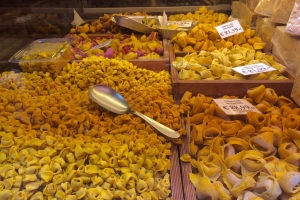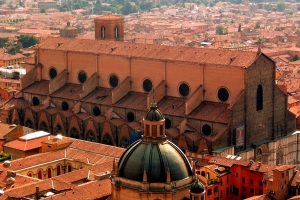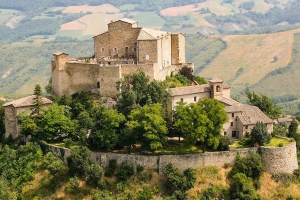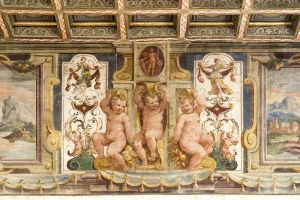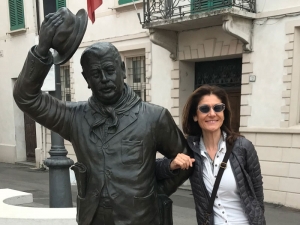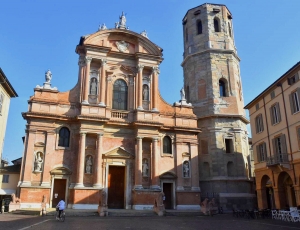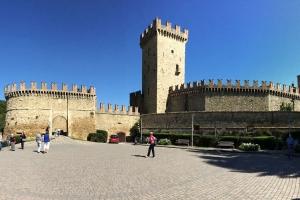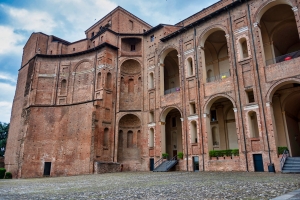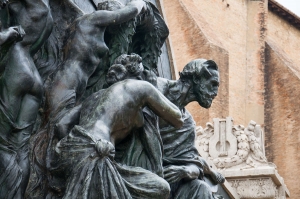Itinera Emilia
Tasty Bologna
A walk in the center of Bologna hunting for the treasures of a city famous, throughout the world, for its good food. Our tour starts with the joy of colors and sounds of the Mercato delle Erbe (Herb Market) to arrive, a few steps from San Petronio and the Two Towers, in the heart of the Mercato Vecchio (Old Market).
Tastings of handmade pasta, cold cuts, cheeses, ice cream, amazing appetizers, all seasoned with the story of the places and products met along the way.
Light and tasty itinerary suitable for everyone.
Classic Bologna
Our classic itinerary includes Piazza Maggiore, with the Palazzo d'Accursio and the Basilica of San Petronio, crosses the Mercato Vecchio (Old Market) with a stop at the Archiginnasio and the Church of Santa Maria della Vita and arrives at the Two Towers. Not to be missed are the complex of the Seven Churches in Piazza Santo Stefano and the church of San Giacomo Maggiore in the university district.
At the end of the tour, a peek at the small window of Via della Piella is a must, revealing how Bologna was once... navigable!
Bologna also offers a very rich pictorial heritage, which ranges from the masters of the sixteenth century between the Renaissance and Mannerism, to the school of Carracci, Guido Reni and Guercino.
The Castles of Matilde (Reggio Emilia)
The itinerary allows you to retrace the traces of one of the greatest female figures of the medieval era, Countess Matilda di Canossa. Between the 11th and 12th centuries Matilda ruled a powerful state, which from Mantua reached almost as far as Rome, defended by a fortified system of castles and towers. Many of these places are now in ruins, but the territory still preserves the traces of that glorious past.
Even the names of the places evoke events and episodes of history: Canossa, very famous for the meeting between Henry IV and Pope Gregory VII in 1077, although in ruins it still stands mighty on the high cliff that dominates the horizon and a landscape made even more suggestive by the presence of the gullies.
Bianello
The only castle still visible of the fortifications that stood on four hills dominating the current town of Quattro Castella, where, every year, the appointment of Matilda as vicar of Italy by the Emperor Henry V. episode is represented through the Matildic Historical Parade of Quattro Castella at the end of spring.
Carpineti
Another mighty castle today reduced to a few ruins but immersed in a breathtaking landscape, still rich in suggestions due to the presence of tower-houses and ancient parish churches.
Rossena
Recognizable by the red color of the rock on which it is placed, the castle of Rossena has been preserved over time, retaining its mighty original appearance. Not far away, reachable on foot, stands the Rossenella watchtower, which was part of the defensive system of the Matildic territory.
Other castles and residences outside the city
Montecchio : built in the era of Matilde, the castle retains its medieval appearance. The itinerary includes a visit to the underground and the ascent to the Torrione.
Scandiano : the poet Matteo Maria Boiardo was born in the castle, where Francesco Petrarca, Calvino and Pope Paolo III Farnese stayed. Giovan Battista Aleotti gave it its present shape and the Este family transformed it into an elegant mansion.
Correggio : here is the splendid Palazzo dei Principi, home of the da Correggio, lords of these lands in the Renaissance era. It is accessed through the elegant sixteenth-century portal.
Novellara : from medieval fortress to noble residence under the Gonzaga family, the Rocca di Novellara, with richly decorated grotesque rooms, houses a museum that preserves splendid 16th century apothecary jars, a small theater of the nineteenth century and works by Augusto Daolio, unforgotten leader of the “I Nomadi” complex.
Guastalla : the Palazzo Ducale, founded in the fifteenth century, reached its maximum splendor in the second half of the sixteenth century, under Ferrante II Gonzaga. The building is currently undergoing restoration.
Novellara and the small capitals of the Po
Boretto, Brescello, Gualtieri, Guastalla, Luzzara, Novellara, Poviglio, Reggiolo: all centers of the "Bassa" Reggio area united by the presence of the Great River that has always flowed over these lands, characterizing their culture, economy, history and traditions.
The visit of Novellara, with the & nbsp; Rocca dei Gonzaga , the rich Museum, the historic Traditional Acetaia di Aceto Basamico di Reggio Emilia can be combined with a navigation route on the Po: a special day with the relaxed rhythm of the Great River.
The small but well-kept Museum inside the Rocca preserves some fragments of frescoes by Lelio Orsi da Novellara, portraits of the Gonzaga family, and the furnishings of the ancient apothecary.
Brescello with Don Camillo and Peppone: Ciak!
"Here is the country, the small world of a small world, planted somewhere in Northern Italy. There in that flat, fat slice of land between the Po river and the Apennines ..." Giovanni Guareschi's words find their fulfillment in Brescello, a small town in the Lower Po Valley, which has become the natural setting for the heroes Don Camillo and Peppone.
An itinerary unfolds here that includes a visit to the places made famous by the cinema screen and which ends in the Museum where photographs and memorabilia related to films are collected . It is possible to combine this path with the & nbsp; Verdi's places & nbsp; in the Parma area, due to the common origin of Guareschi and Verdi.
Classic Reggio Emilia
The itinerary in the historic centre of Reggio Emilia winds its way through narrow streets, palaces and places of worship with magnificent architectures, such as the Sanctuary of the Beata Vergine della Ghiara, which houses a fresco considered miraculous depicting the "Madonna adoring the Child". A church that is a true example of Emilian artistic production of the time, containing works by Alessandro Tiarini, Orazio Talami and Guercino.
The walk then leads to Piazza Grande, now called Prampolini, overlooked by the Cathedral of Reggio Emilia, where you can admire sculptures by Bartolomeo Spani and Prospero Sogari, the Baptistery and the Town Hall, which houses the prestigious and famous Sala del Tricolore (Tricolour Hall), now used as the Town Council Chamber.
Particularly striking and historically important is the Basilica di San Prospero, dedicated to the patron saint of the city. Inside you can admire a splendid cycle of frescoes by Camillo Procaccini dating back to the late 17th century and wooden stalls by Cristoforo and Lorenzo da Lendinara.
Castell’Arquato (Piacenza)
A walk in the medieval village of Castell'Arquato will allow you to admire dreamlike views and authentic pearls of Medieval history, in an atmosphere suspended between past and present.
Walking through narrow streets and cobbled streets, you will cross the Torrione Farnesiano, the Palazzo del Duca, the former Hospital of Santo Spirito (now home to the Geological Museum), until you reach the scenic square overlooked by the three symbols of the city: the Collegiate Church , symbol of religious power, the Rocca Viscontea , symbol of military power, and the Palazzo del Podestà , symbol of political power.
In addition to the monuments and landscape of the Val D’Arda, the village offers excellent wine tastings , unexpected musical tributes and many opportunities for historical and thematic re-enactments.
It is also included in the Regional Park of Piacenzano , a protected area and rich in sedimentary rock outcrops with an age that varies between 3.5 and 1.8 million years ago.
Village of Vigoleno (Piacenza)
Small but charming fortified village, built on a limestone and sandstone spur that guarantees it a privileged position in the hills, Vigoleno is dominated by the Castle that belonged to the Visconti and then to the Scotti of Piacenza, now a noble residence. There are also the Oratory of the Virgin of Grace and the ancient Pieve di San Giorgio, which can be visited in an enchanting, intimate and silent atmosphere.
Vigolo Marchese
A few kilometers away, the ancient Baptistery of Vigolo Marchese, which flanks the Romanesque church dating back to 1008 the only remnant of a lost monastery. The baptistery, dating back to prior to the church and probably built as a pagan temple in Roman times, is one of the oldest examples of a circular building.
Classic Piacenza
One of the most riche and flourishing cities of the Middle Ages, as evidenced by the numerous palaces and churches in the historic center: the Palazzo Gotico in the famous Piazza Cavalli , the Cathedral and the church of Sant’Antonino. Piacenza was the first capital of the Duchy of Parma and Piacenza and later became the second city of the Farnese state. The colossal Palazzo Farnese designed by Vignola , now home to the Civic Museums, dates back to the second half of the 16th century, whose collections ranging from archeology to the Risorgimento deserve an in-depth visit .
Strolling through the small town center can take you along part of the ancient Farnese bastions and to visit the church of San Sisto, for which Raphael painted the famous Sistine Madonna (now in Dresden), which preserves the tomb of Margaret of Austria, the natural daughter of Charles V and mother of the leader Alessandro Farnese.
Musical Promenades
A journey through the heart of music under the sign of Verdi and Toscanini, discovering the unwavering connection of the city with opera, older than what you expect and deeply rooted. We will talk about arias and concertos, openings and upper balconies, enchanted batons and generous duchesses.
Musical Promenades can be arranged to pass through
- the Regio Theatre
- the Farnese Theatre
- the Opera Museum
- the birthplace of Arturo Toscanini
- the Conservatory of Music
